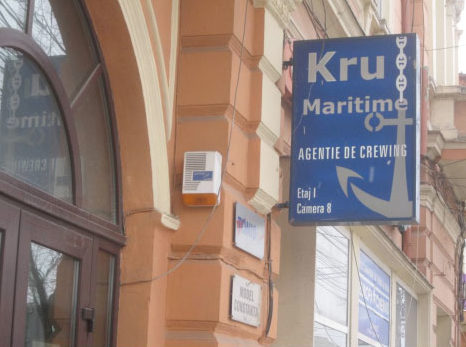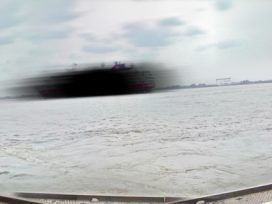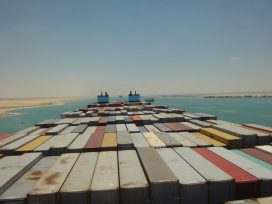Whilst harbour cities have an intrinsic historical association with the movement of goods and people, the upheavals related to globalization that have taken place in their activities and the way in which they are governed mean that this association is itself undergoing radical change. In the near future, harbour cities must simultaneously reinvent their working methods, their town planning and their approach to citizenship. Not only are they a test bench for global circulation but they must also, of necessity, become the main places where, amidst contradictions and conflicts of all kinds, the difficult process of establishing an embryonic multicultural democracy takes place.
Harbour cities at the heart of global traffic
In the new system of production, it is global movement of goods – rather than what is produced nationally – that constitutes the principal source of the wealth. It is this traffic, which, at the transnational level, closely links the three-way flow of material and non-material spheres and the work that turns harbour cities into central points in the post-Fordian economy.
First, from a purely material viewpoint, we are no longer simply talking about the international transport of goods, but rather of global traffic in modules, which are countless and manufactured in a network of firms rather than in a single factory. Also, totally unlike national Ford-style mass production, these parts are assembled and distributed on continental markets. This model of commercial logistics, a product of cooperation as diverse as it is random, exploits skills that differ considerably from the old-style manufacturing hierarchy. For this reason, it is especially harbour cities that have made innovations in logistical traffic that become the chosen sites for this production, material and non-material alike.
There are still some ports clinging on to traditional transport, notably the hubs located at major world crossroads where containers full of modules and spare parts come and go. But the harbour sites that are the most “distinguished” bring together more and more services for this traffic in goods, which is also more and more contextualized. On every continental marine shoreline, a “regional” process of integration in trade is happening, at the same time as the establishment of more long-term river transport systems.
It is a fact that harbour cities must absorb and also produce enormous quantities of information. Contrary to the dominant ultra-liberal ideology that aims to over-value the sphere of the non-material – especially the financial aspect – whilst marginalizing production, harbour cities build up their wealth on the basis of the ever-increasing intensity of the connections between goods and services. Towns in general become the places where new systems of production are invented that go well beyond the centralized hierarchies of industrial companies. Because they are able to access a huge number of exchanges arising from a combination of the two main universal flows resulting from globalization – for goods, the container and for information, the digital highway – harbour cities can be ahead of those changes that are a feature of towns in general, changes that generate the important innovation that we call “productive democracy”.
The essential feature of the various forms of governance of harbour cities is that they make the conflict between those active in the city into something productive. In each city, depending on its particular history and strategies, specific innovations are introduced in terms of civic mechanisms. However the aim is always to discussing and, most importantly, to adopt those solutions that are most favourable for the city, which itself is regarded as being a common tool essential for the prosperity of all. Citizens may pursue activities that are often fiercely competitive, but they will nevertheless cooperate to achieve precise objectives when they feel that they are helpful to their shared situation. Thus, competition and cooperation work hand-in-hand for the benefit of the territory held in common.
These democratic mechanisms relate to both maritime and terrestrial exchanges as these affect the various harbour communities, but they also relate to town planning, or else to the local economy. They are always based on discussions between citizens about a territory that is regarded as being common to each of those involved and to their particular skills. Whether municipal or regional in nature, harbour cities, considered as great purveyors of wealth, are actively supported by their national governments which, in turn, never impose their rule in an authoritarian fashion. By contrast, where there is simply a harbour alongside a town, whether it is governed by a state or a multinational, it will cut a sorry figure in contrast with these productive cities, which have always been able to adapt their governance to the issues that have arisen.
Such places, which are attracting ever more multi-national operators wishing to locate their plant in these nerve centres, are today seeing how globalization is confronting them with enormous changes in their socio-political system. Merchandise handlers, in particular, no longer see themselves as belonging to a particular place and its port community. Harbours are becoming, first and foremost, nothing more than a geographical localization of a global company controlling a much wider commercial presence, and therefore always liable to modify it in response to geo-economic or strategic changes. Although such operators invest gigantic sums in infra- and super-structures in the port, the town and its hinterland, their lack of any socio-political sense of belonging nevertheless differentiates them at a fundamental level from the other members, who define themselves primarily in terms of their status as citizens of the place and as members of the port community. This immediately results in all the tissue of competitive/cooperative relations that are at the heart of the productive effectiveness of a community being called into question, along with the relationship between those active in the port and the town and its local government. In harbour cities, then, globalization appears to encourage a return to competitive relationships and to traditional functional divisions.
Mobility and cultural crisis in harbour cities
Globalization combines movements of persons with movements of goods or of capital and, in this respect too, it has to be a priority to look at harbour cities in order to examine their socio-political consequences. Companies’ new-found mobility derives from the concentration of port enterprises and marine public works that accompanied their internationalization, with each of these aspects reinforcing the other. Industrial production in port areas forms part of the new International Division of Production Processes through modular production methods. Containerization has made it technically possible to increase economies of scale on a site where overall network economies can be achieved. Here too, this will bring about movements of workers, managers and technicians from one port site to another. Investments, both national and international, in such major production sites will therefore cause movements of manpower that will be variously regulated. Several types of work, with differing degrees of mobility, more or less legal and more or less facilitated, coexist on port sites. This causes a process whereby work and citizenship become divided into different sectors.
First of all, harbour cities often have a fluctuation of highly qualified staff. These new nomads of the digital age are not only involved in the world of finance; they are also to be found in the fields of port engineering, logistics, the design of industrial projects, and so on. The emergence of large goods handling and shipping companies that are present in some ports causes movements of manpower within these groups. This phenomenon was rare in the world of ports prior to the 1990s and was more typical of major industrial groups, including those in industrial zones close to ports, such as petrochemicals. But privatization of container terminals and various reshapings of “network enterprises” have sounded the death knell for any kind of exclusive territorial siting for port activities. Nowadays, management also involves the management of container terminals: Moller-Maersk’s Dutch company APM, for example, manages at least 63 container terminals. It practises mobility for its managers on a global scale and very explicitly promotes this aspect of the job when recruiting:
Collaborate across the world: Working with a team of talented professionals in more than sixty countries, you get a chance to experience different cultures and make friends all over the world. When you join APM Terminals, the world is your workplace.
The standpoint of such groups thus substitutes the culture of the enterprise for the culture of the location. However, to qualify this contrast somewhat, we should recall that, during the main period of port trade in raw materials, up to World War II, apprentice businessmen were always trained by having them spend time within establishments linked to their firm but in other ports across the world. By definition, harbour cities have never been islands. In this sense, the “Ford era”, in which certain centralized states such as France were able to restrict their ports to servicing only their hinterland, is no more than yesterday’s digression. Nowadays, university training fits in with the post-industrial network of ports and ensures that logistics managers move around.
This first aspect has historical origins just as port locations have always been places through which migrants passed. From the end of the nineteenth to the first half of the twentieth century, the classic transit operation for European migrants, very often heading for Ellis Island, was a major port installation that involved the sorting of passengers and an entire dependent economy. This kind of migration continues in many ports but is now subject to the enormous growth in the ideology of security. From this point of view, activity related to migration appears as something suffered rather than organized from the point of view of the ports. It is a spectacular paradox that walls are erected around terminals, sometimes made up of containers, as they are at Le Havre, intended to prevent illegal migrants from getting through. Whether they are actually effective is debatable, the intention being rather to demonstrate a political intention than to solve a problem.
Tourism also generates, everywhere, inter-regional and international flows of migrants. The mass cruise market, ranging from Egypt
to the Scandinavian ports, is involved in the new directions taken by port economies and migration, so that illegal migrants are actually often listed in the “tourist” category for administrative purposes.
In the twenty-first century, at least up to the time of the 2008 financial crisis, the economy of port sites was creating new jobs in logistics and distribution and also on building sites connected with the reconstruction of new terminals or logistics depots. This was further enhanced because the growth of ports was now extending far inland with the development of canals linking rivers to the sea and continental logistics depots. A proportion of such jobs has been taken up by migrants of a new kind, “transmigrants”, who are establishing their links with the ports.
For one thing, major development projects, because of the cascading of sub-contracts, appeals to a workforce that is “unofficial”. The same applies to building sites that form part of urban regeneration in former industrial/port areas in the heart of towns, most noticeably for steel framework operations on public projects and in the building trades. This phenomenon is also noticeable in industrial maintenance. Since the first decade of the century it has been accompanied also by transnationalization of employment, because sub-contracting increases the involvement of non-national companies who come along with their own workforce. Whatever the ambiguities of their legal status, many “Polish plumbers” are working in European ports. For example, Hungarian workers were employed to rebuild Le Havre’s power station, located right in the middle of the port, and their accommodation was at the seafarers’ club. In fact, the presence of illegal immigrants or workers employed by foreign firms on temporary building sites can lead to longer stays or to people deciding to settle. Paradoxical though it may seem, the provision of security for warehouses can provide stable employment for individuals whose own status is precarious, so that it is possible to move from a time-limited employment site to more permanent work.
Similarly, changes in working practices in navigation now mean that crews found on French ships are essentially made up of Filipinos and Romanians or nationals of what are sometimes small countries such as the Comoro islanders. Ports such as Constantza or Odessa are specialists in recruitment and organization of the labour market for these seamen and some French shipping companies use them to recruit qualified Romanian mechanics from these towns. There is, therefore, an urban sector for the production of manpower on a continental scale and it is possible to distinguish between points of departure and arrival of migratory flows involving whole flocks of mobile workers.
Even though, for the International Labour Organization, this is the first labour sector that has been “truly globalized”, the restrictions of the ISPS code (International Ship and Port Security) on movements on land by seamen and sometimes also by crews of river boats have applied to them since 9/11. These employees who are well and truly part of the process of globalization are nevertheless still subject to exceptional legislation. Hamburg was one place where objections to, indeed condemnation of the ISPS code, in particular by the chaplains of the Seamen’s Clubs, was most vociferous. Just as in the nineteenth century, ports function with a workforce that is made up of a significant proportion of “floating” workers, in every sense of the term, workers whose status as citizens is problematic. In the view of Alain Tarrius, “to a large extent, such practices derive from the model of ‘transmigrants’ rather than from twentieth-century migrations. These people are itinerants; the port site is a stage on a journey towards another country, another city, rather than a final destination. These jobs are held temporarily and their relationship with the town is that of a flow passing through it rather than a permanent population. This does not exclude the possibility that some of these ‘passengers’ might settle there permanently.”

Recruitment agency for seamen in Costanza, Romania. Photo: Arnaud Le Marchand
The presence of migrants in ports can be extended to include the situation of separate minority groups made up of “internal foreigners” within EU countries. In the case of France, the presence of Romanies amongst the casual dockworkers has been recorded in police archives since before and after World War II and up to the point where the companies ceased to employ them. They were there on a seasonal basis, but evidence of a link between port employment and travellers continues until the 1960s. In secondary ports (such as Dieppe for example), they could still be found throughout the twentieth century amongst “occasional” dock workers. This is because the intermittent nature of the work, associated with their precarious status, always represents a reservoir of employment for persons whose citizen status is relative, in this case because of their nomadic way of life. This is a matter that constitutes one of the hidden features of the social history of French, and perhaps of European ports. Major changes in marine traffic may point to another such feature. Like sailors and fairground people, bargees were, throughout the twentieth century, a professional group apart which had union links with fairground people. Their mobile dwelling-place (whether on water or on wheels) was a marginalizing factor for some of the port workforce throughout the twentieth century. This did not mean that these groups found social and political support in harbour cities, a fact that raises questions about the ability of such places to achieve integration.
This mobility, central to how harbour cities function, creates a new kind of migrant who is no longer the settled migrant of the twentieth-century industrial era. Inasmuch as he is a direct participant in globalization, a new kind of actor in social networks that directly produce movements of goods, services (the “Polish plumber”) and training, the dream and reality for today’s young migrant is no longer to settle in France and work there for decades, just going home to see his family at holiday times. He comes here to gain a qualification in the form of a master’s degree and continues to travel from one major workplace or business to another. The aim is to achieve freedom to work by becoming part of some international network of movement from one country to another, crossing frontiers like a trader or foreign worker. This kind of transmigrant is a major feature of globalization and is particularly to be found in the harbour cities of the twenty-first century. He has been clearly identified by research into migration but most governments, whether local or national take little account of his existence.
Mobility of labour is the central component in the new productive order but comes into conflict with local governance. The problem is the more acute because the employment policies of large companies favour segmentation and discrimination as disciplinary procedures when it comes to reducing labour costs and making themselves more profitable. This represents a challenge to the governance of harbour cities, which are, first and foremost, political constructs rather than just simply accumulations of infrastructure and companies. When consider by contrast with against other inhabitants of the city, these employees, whether temporary or permanent, but with fewer rights and lower salaries, are seen as lesser citizens.
In these cities with high employment rates, it is not actually unemployment that explains the tensions between the resident population and those who are just passing through. Such tensions can become extreme through increases in votes for xenophobic parties (Antwerp is a case in point). What is really at stake in such conflicts is the place occupied by these new workers in the city, because it brings with it diversity in cultural practices, including those connected with the sea port, that call in question the image of the city as a relatively homogenous community. Work in the docks such as logistics, or seafaring itself for that matter, is no longer the privileged domain of the natives of certain harbour cities in Europe because it now has to be shared with minority groups. Consequently, today we must assume that there will be major changes within port cultures. In order to create a bond between all the inhabitants associated with the businessmen and dockers, each culture must subscribe to the same technical system and the need to cope with whatever chance throws at them in order to continue to support the community. But these communities are today much more diverse at the same time as they are spreading across several towns simultaneously. Under these circumstances the classic basis of culture, a town’s history and common destiny, is not enough when your aim is to organize basic levels of cooperation with other populations participating in the local economy. The danger of port cultures being shattered is combined with a proliferation of enclaves, of professional and technical segregation, that is gradually causing harbour cities to become fragmented. The risk is further increased by new global infrastructures and the tunnel effects that accentuate divisions between harbour cities. It is perhaps in Asia that this tendency towards break-up can be most clearly seen.
The mixture of antagonism and community relations that characterizes harbour cities has been greatly destabilized. A considerable proportion of the social history of each port-city is traditionally founded on a very strong feeling, one that is widespread among seafarers, dock workers and bargees, of being a “race apart”, and the response to it on the part of those who govern the port-city is one of rejection. But in the municipal ports of northern Europe this is combined with an equally strong and shared sense of belonging to the place, a feeling that has for a long time made it possible for conflicts between employers and employees to find local solutions to a noticeably greater extent than in state-owned ports in southern Europe. Such community action, which can certainly still be encountered, can be fractured by a very small proportion of “permanent residents” in the port’s logistics operations as by an influx of migrants.
Thus, where local management becomes global it poses a real problem of adaptation to the kind of urban democracy that has been characteristic of major harbour cities. This is all the more likely in that such a transition goes along with the new method for financing infrastructures, recourse to securitization and internationalization of labour and professional cultures.
Harbour cities as test benches for “glocal” governance
What is to be the place in the port-city for all these new globalized workers? What new directions will conflict take? Throughout the twentieth century, the institutions of professional communities were an instrument for regulating local conflicts between the various interests in port professions which were, for the most part, local and national, ranging from dock workers to warehousemen, businessmen, crews and freight agents. Such institutions aimed to ensure that the activities carried on in that place might develop. In the twenty-first century, new conflicts have arisen related to mobility on a global scale, be it financial, material, non-material or human; the national framework has been shattered. Seizure of power by multinationals, especially major operators in the field of goods handling, has changed the chain of production of the local area, with stevedores, logistics specialists and dock workers becoming employees of the companies. This new power represents a challenge to the governance of the site as a whole in the face of the new global, capitalist logic, and the issues and conflicts that exist between these companies and the port site are manifold.
In this respect the port-city becomes a test bench for examining the new glocal dimension that governance of cities must embrace. Urban planning and finance speak with one voice on the subject of a uniform “metropolization” under way across the world – as towns become showplaces, property rentals in the centres going through the roof whilst the outskirts become favelas – while political scientists endlessly preach “best-practice solutions”. But ideas about speculation and gentrification only provide a partial explanation for these new problems. Regeneration of the wastelands must also be understood in relation to the specific economic strategies that apply to each place. One needs to go beyond the industrial era once and for all if one is to position oneself within the network of world port metropolises.
Wastelands are not just places that have been emptied of any usefulness in terms of production; they also include impoverished, inhabited areas. That is where one finds the new, settled globalization migrants. That is where squats begin to appear. That is also where new, middle-class inhabitants settle. That is where new forms of governance are tried out and where the question of democracy is fundamental to the implementation of the plans for and the future of the port-city.
Although all Europe’s harbour cities today are locations for major urban plans, the provisions made are very different. This is because the cities are plural and multiple and represent complex economic units, each with its own specific history and democratic practices. Most importantly, strategies for industrial wastelands are an occasion for democratic discussions and conflicts that involve what is glocal, since regeneration implies that both residents and non-residents, both local and global migrants are involved.
In France it is participatory democracy that rules supreme, with what are sometimes sophisticated provisions that can often be summed up as “PowerPoint Presentation Democracy” – nothing more than a classroom presentation of the project by those in power to the inhabitants who are considered to be nothing more than “users”. Such participatory processes are based on a consensus ideology that is specific to a centralized form of power that does not include the creative potential present in society. A universalist, assimilationist ideology of “social mixing” may even go as far as the refusal to take into account the increasingly multicultural nature of harbour cities. Introducing some of the provisions made by northern European cities, involving different ways of managing conflicts can open up other perspectives.
From a French standpoint, it is important to consider the advances in the practice of governance made by the major projects undertaken in Antwerp, Hamburg, Amsterdam or Rotterdam. They have not only been thought of as urban planning but as being focused on the development of the town as a whole in the long term, making it possible to include consideration of the city’s economy. A variety of types of procedure for diagnosis and planning involve discussion with citizens admittedly on economic and urban issues, but they include social questions too.
Similarly Hamburg’s International Building Exhibition (IBA), as part of the operation that it calls “Leap over the Elbe”, has christened one of its projects “Kosmopolis”, and requires it to consider the forty or so nationalities, totalling 55,000 people living in the very heart of the city. The idea of conceiving the metropolis of tomorrow as a cosmopolitan city and explicitly asking the question: “How do you turn diversity into a strength?” amounts to an attempt to break down the barriers in the city by restoring the connections between what are, at present, the separate worlds of the centre and the periphery. A policy of promoting a variety of cultures is at the centre of actions to redevelop areas, as is made explicit in the name given to the plan for estates in the so-called “World Quarter” or the plan for children’s education, “The new world class: An educational offensive on the Elbe Islands”.
This plan to achieve urban, economic and social integration makes sense in the context of globalization, given the considerable presence of foreigners, both managers and poor immigrants, in these harbour cities, these world cities that attract people from everywhere. It is also essential in the face of the increase in xenophobia in elections in Hamburg, just as in Antwerp, towns that, as harbour cities, are at the forefront of globalization-related mobility. The overall aim of these provisions is indeed to construct a twenty-first-century metropolis, with real estate, just like everywhere else, but with the aim of building on the basis of a shared vision, taking into account size, emotional responses, representations and cultures, not excluding the tensions that already exist. Even though they may have their limits, the democratic processes that have been put in place are more deliberative than simply participatory and appear to be directly productive of local governance by representing a place where conflicts might be expressed.
Barcelona has shown that a major regeneration operation can be a time for the town to mobilize and to promote its local strengths, with its process of strategic planning put in place in the 1990s to assert the primacy of public dynamism in the face of the speculative, Anglo-Saxon view of the construction industry that was dominant at the time. The key words of the plan were citizen mobilization and discussion. It resulted in a reshaping of working-class areas such as Barceloneta, mixing together a local population traditionally linked to the port and new, middle-class inhabitants, with the creation of long public beaches and keeping many of the occupants in renovated properties. The idea was to fly in the face of the logic of massive expropriation that had been dominant throughout the decade, such as took place in American towns or in London’s Docklands. This different dynamic of urban reshaping was combined with economic opening up that linked regional development to globalization, including in particular heavy logistical investment around the new port and airport. Going well beyond the dominant, banal explanations, couched in terms of communication, Barcelona seems to us to be, above all, a privileged example of a post-Fordian, productive city in its ability to mobilize all the city’s strengths and emotions to create a southern European metropolis.
But Barcelona also shows that this democratic setting-up process needs to be continually reinvented as is shown by the current property madness that is giving free rein to speculation and corruption. There is no universal democratic model for cities, no matter what the exponents of best practice may say. Hamburg’s IBA or Barcelona’s strategic plan are not recipes that can be reproduced elsewhere just as they stand. A democratic process needs to be set up in each city, to include dissenting voices, with approaches to governance that are very diverse and specific to local subjectivity, that is to the city’s history and its customs. This means that governance will be an ongoing process of invention and transformation that goes far beyond any so-called universal standards preached by political scientists. For an area that is treated as being held in common, making dissenting views productive is always going to be a complex process within any city.
So the city seems to us to have become the perfect setting to bring conflicts into a state of democratic tension. The various rights of citizens to mobility or housing are always most concretely expressed in the context of a discussion about “What kind of a city do we want?” Following Henri Lefebvre, David Harvey speaks of a “right to a city that is more collective than individual because, in order to change the city, we must, of necessity, have collective power over the processes of urbanization”. We have tried to show that harbour cities today do indeed demonstrate this need to make a priority of investing cities with a citizen’s point of view: only mobilization of the enormous potential for initiatives and creativity of living in the city, with all its difficulties, will make it possible to create a metropolis. In order to go beyond the old state omnipotence and the type of democracy based on delegation, this promotion of cities as the most important centres of democracy in the age of globalization fulfils Europe’s founding principle of subsidiarity. Harbour cities, where economics and a multicultural dimension come together, are the prime venues for discussion of the concrete methods whereby this crucial principle can be applied, and thus to reinvent citizenship that today is still in the hands of governments.








